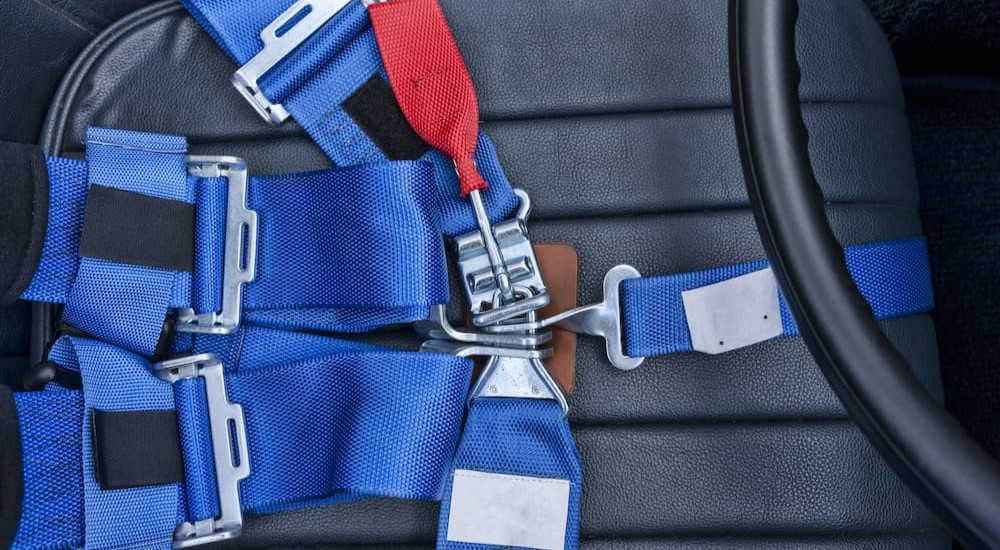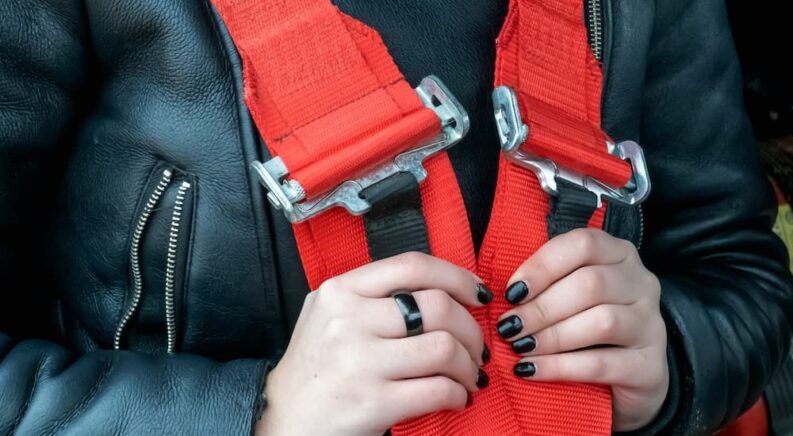Installing a racing harness is one of the most important steps in the process of transforming your vehicle into a track-ready racer. Sure, they might not be as glamorous as slick racing tires, cold-air intakes, or coilover suspension, but racing harnesses do fulfill a vital role in improving the safety of any race worthy-vehicle and are actually required if you’re looking to participate in many racing events. Few drivers realize that race harnesses aren’t just about creating a safer driving experience; they can also have a big impact on performance due to the way they reduce fatigue and keep the driver firmly positioned in their seat. However, from expiration dates and latch styles to additional costs and the debate between SFI and FIA-certified products, there’s a lot to learn about this vital piece of safety equipment, so join us as we dive in and explore some important race harness dos and don’ts.

Check the Expiration Date
If you’re going to go to all the effort of installing a race harness––and all the associated equipment––chances are you’re a regular at your local track or a member of a local High-Performance Driver Education (HDPE) club. These tracks and clubs are a well-organized way to test your mettle and racing skills, but they often come with their own set of safety requirements. These organizations typically require drivers to outfit their vehicles with SFI or FIA-approved gear, including safety harnesses.
Race harnesses not only need to be up to snuff when it comes to their construction, but they also have expiration dates. Every race harness comes with a prescribed service life due to the wear and tear that comes with repeated use, and the clock starts ticking as soon as the belt is manufactured. Historically speaking, many HDPE clubs and tracks aren’t that concerned with the in-date as long as it doesn’t show any obvious signs of wear, but this is beginning to change. For a long time, racers have been able to get away with buying expired or “retired” harnesses from those competing in race events with higher safety standards, though the practice is falling out of favor as clubs and tracks look to shield themselves from liability.
Don’t Forget the Difference Between SFI and FIA
In the world of motorsports, standards for safety equipment like race harnesses are overseen by two competing organizations: SEMA Foundation, Inc. (SFI) and the Fédération Internationale de l’Automobile (FIA), which is also the governing body behind Formula One and other racing events. The two organizations agree on a lot of things when it comes to safety requirements for racing equipment, but race harness service life isn’t one of them.
The SFI is the stricter of the two organizations, rating race harnesses for two years from their date of manufacture. On the other hand, the FIA rates race harnesses for five years, giving drivers more than twice the service life to play with. As one might expect, the longer-rated equipment comes at a premium, with FIA-approved gear typically costing a little more on average than its SFI-approved counterpart. If you’re a casual racer looking to level up your vehicle’s safety setup, FIA-approved equipment is clearly the better value. That said, SFI has the edge when it comes to certain U.S.-based series like circle track and drag racing, where the FIA gear isn’t recognized.
Know the Difference Between Latch Types
Race harnesses differ in a number of important ways, including belt length, number of points, and latch types. While these largely come down to a matter of individual taste, comfort, and convenience, there are some important differences to be aware of. Let’s start with latch types, which come in both latch-and-link and cam-style designs. Latch-and-link harnesses are the most common type and basically involve hooks that latch onto a central loop. Once all five or six hooks are looped, drivers simply need to push a latch lever, which locks everything into place. Latch-and-link style harnesses are reliable but can take a little getting used to and aren’t quite as easy to disengage as cam-style harnesses.
A cam lock latch operates in a way that’s not that dissimilar from the traditional three-point seatbelt found in most vehicles. Instead of a bunch of loops and latches, the belts all end in a latch “tongue” like the one found in the average seatbelt. These latching tongues are inserted into a central hub, where they’ll lock into place once they’re pressed deep enough. Releasing the latching tongues is as easy as rotating the central lever or knob, which causes a cam inside the hub to free all five or six points at the same time. Cam-style harnesses are easier to operate than latch-and-link versions but also tend to be more expensive. Some regulatory bodies like the FIA have outlawed the use of latch-and-link-style harnesses altogether, so make sure to check the requirements of your local racing club or track before making the investment.
Consider a Six-Point Harness
Aside from latch type, the number of points that a harness has is one of the biggest differences between models. As the name implies, five-point harnesses have five different belts holding the driver in place, while six-point harnesses up the security by one belt. Both harnesses feature straps to go over the shoulder, around the waist, and between the legs, but the last category is where the two designs differ. A five-point harness features a single belt between the legs, which runs right up the middle of the groin. Six-point harnesses are built with two straps between the legs, which hug the inner thigh instead of the groin. This design offers improved security over the five-point style, which is why the FIA doesn’t currently approve any five-point harnesses for use in its events. Understandably, comfort is also often a deciding factor when it comes to choosing a six-point harness.
Only Install a Harness If You Need It
Few things are quite as satisfying as having the right tool for the job, but all too often, drivers tend to go a little overboard when it comes to outfitting their vehicles. Sure, it’s fun to tinker and make improvements, but you also have to be honest with yourself about how a vehicle is going to be used. For example, your daily driver probably doesn’t need a roll cage, and an oversized tailpipe is going to do nothing but draw the ire of everyone within hearing distance. The same is true for race harnesses. They’re an essential feature on any purpose-built track car but will be overkill when thrown into the average vehicle. Race harnesses are expensive–especially when you consider all the additional equipment they require–and limit your range of motion, which can make riding in your car less enjoyable.
Be Aware of Additional Investments
As we alluded to above, you can’t simply throw a race harness into a car and call it a day. Race harnesses are part of an integrated suite of safety systems that work together to improve on-track safety. First, and most importantly, is the seat itself. A five or six-point racing harness can’t be thrown onto any old stock seat; it requires a specialized––and expensive––race seat that’s designed with slots for each of the straps to pass through, and that’s just the tip of the iceberg. A racing harness also needs a harness bar to attach to, which means the installation of a roll bar or cage. Lastly, you’ll need a helmet and a HANS (Head and Neck Support) device, which improves safety by limiting the forward motion of a driver’s head in the event of a crash. This can represent a significant investment for some drivers, so before you get your heart set on a race harness, make sure to factor in all the associated costs.
Don’t Leave Safety to Chance
A safety harness might not be at the top of your list when you set out to build your next track-ready racer, but it should be. After all, what’s the point of investing a king’s ransom in high-performance components if the vehicle itself isn’t safe? Between a race seat, roll bar, HANS device, and more, a complete racing harness setup can easily cost a couple thousand dollars, but that pales in comparison to the type of medical bills you might be faced with if things go wrong. Hopefully, this guide of race harness dos and don’ts has given you a better idea of what to look for––and what to avoid––when it comes time to outfit your vehicle, but as always, ask the experts if you’re in doubt. Racing might be all about risk-taking and high-speed thrills, but your safety setup is one area where you don’t want to leave things to chance.

